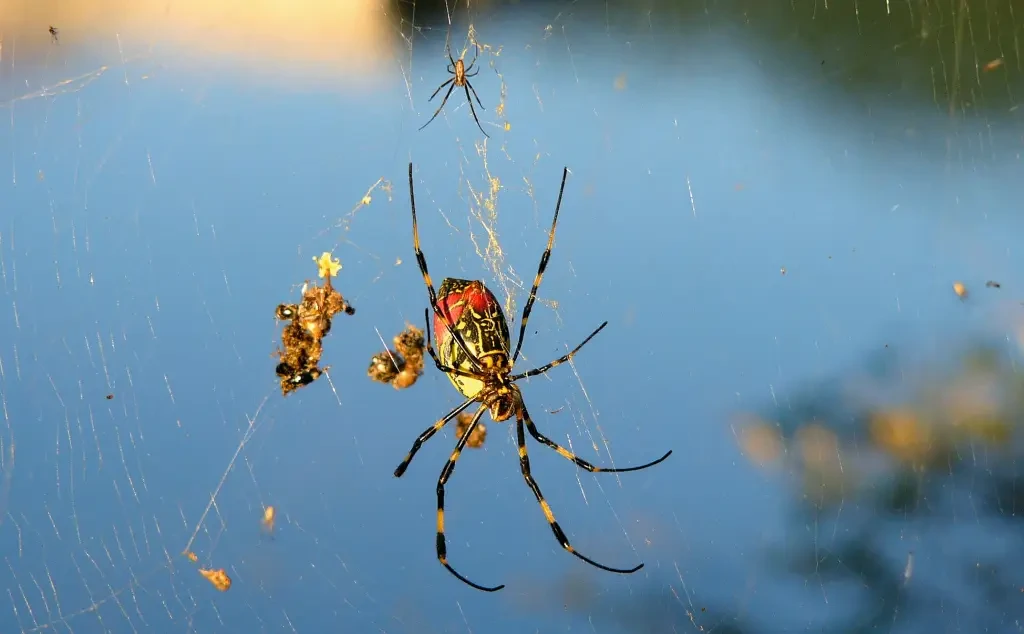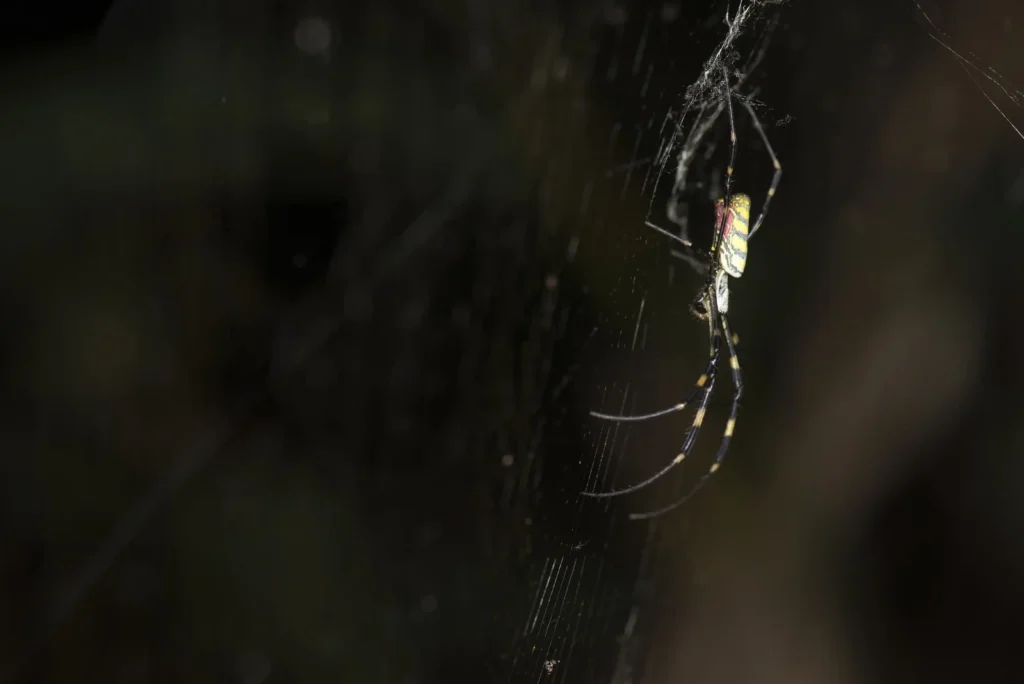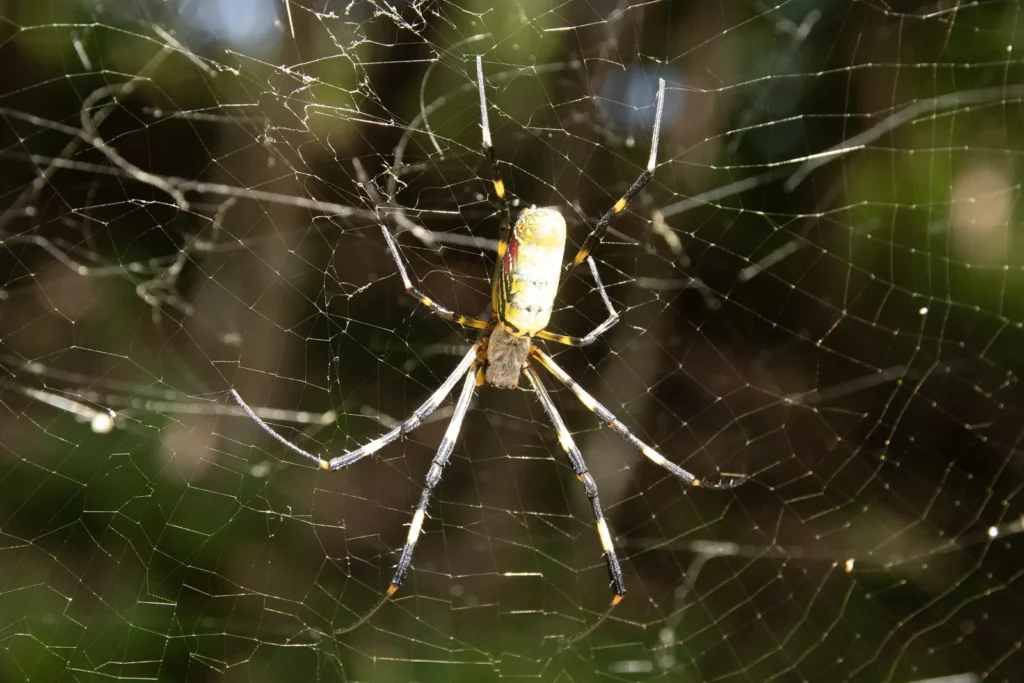Trichonephila clavata, known as japanese spider gioro, is one of the most colorful spiders in Asia. Its distinctive yellow-black body pattern, large size, and ability to weave huge golden webs make it easily recognizable.
📌 What makes this spider unique?
✔ Exotic appearance - bright yellow and black colors
✔ Giant spider webs - durable and visible in light
✔ Females are much larger than males - typical sexual dimorphism
✔ The range is expanding - appeared even in the USA
✔ Toxic, but not fatal to humans
Let's take a closer look at all aspects of this impressive spider!

Scientific classification
✔ The Kingdom: Animals (Animalia)
✔ Type: Arthropods (Arthropoda)
✔ Class: Arachnids (Arachnida)
✔ Row: Pavuk (Araneae)
✔ Family: Weaver spiders (Araneidae)
✔ Gender: Trichonephila
✔ View: Trichonephila clavata
📌 This species formerly belonged to the genus Nephila, but was moved to Trichonephila due to new research.
Appearance and dimensions
🕷 What does the Japanese Gioro spider look like?
✔ Size:
• Females - up to 30 mm (without paws), up to 10 cm (with paws)
• Males - only 7-10 mm
✔ Colour:
• Females - yellow-black with red markings on the abdomen
• Males - brown, less noticeable
✔ Long legs: black with yellow stripes
✔ Body shape: elongated abdomen, similar to other weaver spiders
📌 This spider impresses with its coloration and large size – one of the largest weaver spiders in the world!
Distribution area
🌍 Where does the Gioro spider live?
✔ Native range:
• Japan � 🇯 �
• Korea � 🇰 �
• China � 🇨 �
• Taiwan � 🇹 �
✔ New habitats:
* USA (since 2013 – Georgia, Tennessee, South Carolina)
* Some other parts of North America
📌 The Gioro spider is considered an invasive species in the United States and is actively spreading due to its ability to move with the help of a “spider parachute”.

Behavior and lifestyle
🌿 How does Trichonephila clavata live?
✔ Passive Hunter - weaves huge, strong webs
✔ The web can reach 2-3 meters in diameter
✔ The web has a golden hue in the sun
✔ Males seek out females, but may be eaten after mating.
📌 These spiders rarely attack if left undisturbed, and do not pose a deadly threat to humans.
Food
🍽 What does the Gioro spider eat?
✔ Insects (cicadas, wasps, flies)
✔ Small spiders
✔ Sometimes small frogs or lizards
📌 Thanks to their huge webs, they catch much more insects than ordinary weaver spiders.
Reproduction
❤️ How does Trichonephila clavata reproduce?
✔ Mating season-autumn
✔ The male creeps up on the female cautiously
✔ After mating, the female can eat it
✔ The eggs are laid in cocoons that can contain hundreds of eggs.
✔ Young spiders hatch in spring and grow quickly
📌 Females live longer than males - they can survive several seasons.
Poison and danger to humans
🚨 Is the Gioro spider dangerous to humans?
✔ The poison paralyzes insects, but is not fatal to humans
✔ May cause pain, swelling, and redness
✔ Allergic reactions are possible, but rare
✔ Bites are rare because the spider is not aggressive
📌 If you are bitten by a Gioro spider, it is enough to cool the bite site and monitor the body's reaction. In most cases, the symptoms disappear after a few days.
How did Trichonephila clavata get to the United States?
🇺🇸 The Gioro spider has become invasive in the US, but how?
✔ Probably arrived in containers with cargo from Asia
✔ Perfectly adapted to the new climate
✔ Uses spider-web “parachutes " to spread-winds carry them for tens of kilometers
📌 Researchers do not consider it a threat to the local ecosystem, as it helps control the number of insects.
Interesting facts
💡 The web of Trichonephila clavata is so strong that in Japan it was used to make fabrics!
💡 Its web is golden in color and can shine in the sun!
💡 The female can create a web more than 3 meters wide!
💡 Trichonephila clavata can survive the cold-unlike many other tropical spiders!

Can I keep it at home?
🏡 Can I have Trichonephila clavata as a pet?
✔ Can be kept in terrariums
✔ Requires no special care - just insects to feed
✔ Not dangerous for humans
✔ Requires a large space to weave the web
📌 But remember that this is a predator, and only experienced spider owners should keep it!
Conclusion
🕷 Trichonephila clavata - this is a bright, large and unique spider that weaves golden webs and catches large prey in them. It is not aggressive and rarely bites people, but its appearance in the United States is of scientific interest.
❗ Do not be afraid of these spiders-they are more likely to benefit by destroying harmful insects than harm humans!